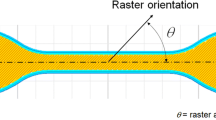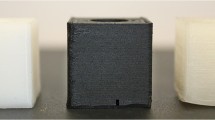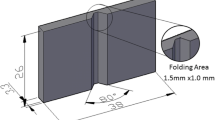Abstract
Lightweight and durable flexible materials with good mechanical properties, reliability, and excellent environmental compatibility have been increasingly widely applied in the field of wearable devices, microelectronics, and soft robots. An orthogonal experimental method was applied to fabricate thermoplastic polyurethane elastomer rubber (TPU) using fused deposition melting technology. The influence of three processing parameters on the mechanical property of the samples was investigated. The optimized printing parameters are 230 °C for the nozzle temperature, 0.1 mm for the thickness of the printing layer, and 100% for the filling percentage. The relationship between the fracture surface and the filling angle of the specimen under tensile stress was analyzed. To realize the lightweight of planar structural materials by melt deposition molding, nine types of planar porous structures were designed based on different average connectivity. The tensile stress simulation was carried out to obtain further the distribution of stress and the location of stress concentration. The relationship between relative density, fracture strength, and elongation at break was analyzed by static tensile test. The fracture morphology of the sample was observed and compared with the simulation results, which indicated that the hexagonal planar porous structure achieved the best balance between structural lightweight and mechanical properties.













Similar content being viewed by others
Data Availability
The datasets generated and analyzed during the current study are available from the corresponding author upon reasonable request.
Reference
D. Gu, X. Shi, R. Poprawe, D.L. Bourell, R. Setchi, and J. Zhu, Material-Structure-Performance Integrated Laser-Metal Additive Manufacturing, Science, 2021, 372(6545), p eabg1487.
Y. Lu, S. Su, S. Zhang, Y. Huang, Z. Qin, X. Lu, and W. Chen, Controllable Additive Manufacturing of Gradient Bulk Metallic Glass Composite with High Strength and Tensile Ductility, Acta Mater., 2021, 206, p 116632.
G. Liu, X. Zhang, X. Chen, Y. He, L. Cheng, M. Huo, J. Yin, F. Hao, S. Chen, P. Wang, S. Yi, L. Wan, Z. Mao, Z. Chen, X. Wang, Z. Cao, and J. Lu, Additive Manufacturing of Structural Materials, Mater. Sci. Eng. R. Rep., 2021, 145, p 100596.
M. Ouhsti, B. Haddadi, and B. Soufiane, Effect of Printing Parameters on the Mechanical Properties of Parts Fabricated with Open-Source 3D Printers in PLA by Fused Deposition Modeling, Mech. Mech. Eng., 2018, 22, p 895–907.
Y. Zhang, L. Wu, M. Zou, L. Zhang, and Y. Song, Suppressing the Step Effect of 3D Printing for Constructing Contact Lenses, Adv. Mater., 2022, 34(4), p 2270030.
D. Ahn, L.M. Stevens, K. Zhou, and Z.A. Page, Additives for Ambient 3D Printing with Visible Light, Adv. Mater., 2021, 33(44), p 2104906.
T. Xu, W. Shen, X. Lin, and Y.M. Xie, Mechanical Properties of Additively Manufactured Thermoplastic Polyurethane (TPU) Material Affected by Various Processing Parameters, Polymers, 2020, 12(12), p 3010.
J. Wang, B. Yang, X. Lin, L. Gao, T. Liu, Y. Lu, and R. Wang, Research of TPU Materials for 3D Printing Aiming at Non-Pneumatic Tires by FDM Method, Polymers, 2020, 12(11), p 2492.
Z. Jingwei, L. Jia, H. Chuhao, and C. Shuo, Study on Dynamic Viscoelastic Constitutive Model of Nonwater Reacted Polyurethane Grouting Materials Based on DMA, Rev. Adv. Mater. Sci., 2022, 61(1), p 238–249.
S. Nathaphan and W. Trutassanawin, Effects of Process Parameters on Compressive Property of FDM with ABS, Rapid Prototyp. J., 2021, 27(5), p 905–917.
S. Nair, S. Panda, A. Tripathi, and N. Neithalath, Relating Print Velocity and Extrusion Characteristics of 3D-Printable Cementitious Binders: Implications Towards Testing Methods, Addit. Manuf., 2021, 46, p 102127.
A. Gleadall, I. Ashcroft, and J. Segal, VOLCO: A predictive Model for 3D Printed Microarchitecture, Addit. Manuf., 2018, 21, p 605–618.
L. Ritzen, V. Montano, and S.J. Garcia, 3D Printing of a Self-Healing Thermoplastic Polyurethane through FDM: From Polymer Slab to Mechanical Assessment, Polymers, 2021, 13(2), p 305.
E. Głowińska, O. Gotkiewicz, and P. Kosmela, Sustainable Strategy for Algae Biomass Waste Management via Development of Novel Bio-Based Thermoplastic Polyurethane Elastomers Composites, Molecules, 2023, 28(1), p 436.
A. Haryńska, I. Carayon, P. Kosmela, A. Brillowska-Dąbrowska, M. Łapiński, J. Kucińska-Lipka, and H. Janik, Processing of Polyester-Urethane Filament and Characterization of FFF 3D Printed Elastic Porous Structures with Potential in Cancellous Bone Tissue Engineering, Materials, 2020, 13(19), p 4457.
A. Georgopoulou, L. Egloff, B. Vanderborght, and F. Clemens, A Sensorized Soft Pneumatic Actuator Fabricated with Extrusion-Based Additive Manufacturing, Actuators, 2021, 10(5), p 102.
A. Bhat, S. Budholiya, S.A. Raj, M.T.H. Sultan, D. Hui, A.U.M. Shah, and S.N.A. Safri, Review on Nanocomposites Based on Aerospace Applications, Nanotechnol. Rev., 2021, 10(1), p 237–253.
D.J.N. Amorim, T. Nachtigall, and M.B. Alonso, Exploring mechanical meta-material structures through personalised shoe sole design, in Proceedings of the 3rd Annual ACM Symposium on Computational Fabricationed. (Association for Computing Machinery, 2019), p. Article 2
J. Podroužek, M. Marcon, K. Ninčević, and R. Wan-Wendner, Bio-Inspired 3D Infill Patterns for Additive Manufacturing and Structural Applications, Materials, 2019, 12(3), p 499.
Y. Wang, X. Ren, Z. Chen, Y. Jiang, X. Cao, S. Fang, T. Zhao, Y. Li, and D. Fang, Numerical and Experimental Studies on Compressive Behavior of Gyroid Lattice Cylindrical Shells, Mater. Des., 2020, 186, p 108340.
L. Rodríguez-Parada, S. de la Rosa, and P.F. Mayuet, Influence of 3D-Printed TPU Properties for the Design of Elastic Products, Polymers, 2021, 13(15), p 2519.
M. Pagac, D. Schwarz, J. Petru, and S. Polzer, 3D Printed Polyurethane Exhibits Isotropic Elastic Behavior Despite its Anisotropic Surface, Rapid Prototyp. J., 2020, 26(8), p 1371–1378.
V. Beloshenko, Y. Beygelzimer, V. Chishko, B. Savchenko, N. Sova, D. Verbylo, A. Voznyak, and I. Vozniak, Mechanical Properties of Flexible TPU-Based 3D Printed Lattice Structures: Role of Lattice Cut Direction and Architecture, Polymers, 2021, 13(17), p 2986.
Y.B. Victor Beloshenko, V. Chishko, B. Savchenko, N. Sova, D. Verbylo, and I. Vozniak, Mechanical Properties of Thermoplastic Polyurethane-Based Three-Dimensional-Printed Lattice Structures: Role of Build Orientation, Loading Direction, and Filler, 3D Print. Addit. Manuf., 2023, 10(2), p 245–255.
C. González, J.J. Vilatela, J.M. Molina-Aldareguía, C.S. Lopes, and J. Llorca, Structural Composites for Multifunctional Applications: Current Challenges and Future Trends, Prog. Mater Sci., 2017, 89, p 194–251.
S. Yuan, S. Li, J. Zhu, and Y. Tang, Additive Manufacturing of Polymeric Composites from Material Processing to Structural Design, Compos. B Eng., 2021, 219, p 108903.
Y.G. Zhou, B. Su, and L.S. Turng, Deposition-Induced Effects of Isotactic Polypropylene and Polycarbonate Composites During Fused Deposition Modeling, Rapid Prototyp. J., 2017, 23(5), p 869–880.
J. Tang, Y. Wu, S. Ma, T. Yan, and Z. Pan, Flexible Strain Sensor Based on CNT/TPU Composite Nanofiber Yarn for Smart Sports Bandage, Compos. B Eng., 2022, 232, p 109605.
Y. Luo, Y. Xie, W. Geng, J. Chu, H. Wu, D. Xie, X. Sheng, and Y. Mei, Boosting fire Safety and Mechanical Performance of Thermoplastic Polyurethane by the Face-to-Face Two-Dimensional Phosphorene/MXene Architecture, J. Mater. Sci. Technol., 2022, 129, p 27–39.
G. Sang, P. Xu, T. Yan, V. Murugadoss, N. Naik, Y. Ding, and Z. Guo, Interface Engineered Microcellular Magnetic Conductive Polyurethane Nanocomposite Foams for Electromagnetic Interference Shielding, Nano-Micro Lett., 2021, 13(1), p 153.
Y.-G. Zhou, J.-R. Zou, H.-H. Wu, and B.-P. Xu, Balance between Bonding and Deposition During Fused Deposition Modeling of Polycarbonate and Acrylonitrile-Butadiene-Styrene Composites, Polym. Compos., 2020, 41(1), p 60–72.
P. He, H. Lu, H. Ruan, C. Wang, Q. Zhang, Z. Huang, and J. Liu, Mechanochemistry: An Efficient Way to Recycle Thermoset Polyurethanes, Polymers, 2022, 14(16), p 3277.
C. Bellis and M. Bonnet, A FEM-Based Topological Sensitivity Approach for Fast Qualitative Identification of Buried Cavities from Elastodynamic Overdetermined Boundary Data, Int. J. Solids Struct., 2010, 47(9), p 1221–1242.
V.S. Deshpande, M.F. Ashby, and N.A. Fleck, Foam Topology: Bending Versus Stretching Dominated Architectures, Acta Mater., 2001, 49(6), p 1035–1040.
S. Zhao, H. Zhang, Y. Feng, and Y. Hang, Effect of Diffusion on Interfacial Properties of Polyurethane-Modified Asphalt–Aggregate Using Molecular Dynamic Simulation, Rev. Adv. Mater. Sci., 2022, 61(1), p 778–794.
M. Mooney, A Theory of Large Elastic Deformation, J. Appl. Phys., 2004, 11(9), p 582–592.
R.S. Rivlin and G.I. Taylor, Large Elastic Deformations of Isotropic Materials. I. Fundamental Concepts, Philos. Trans. R. Soc. Lond. Ser. Math. Phys. Sci., 1948, 240(822), p 459–490.
M.D. Gajewski and M. Miecznikowski, Assessment of the Suitability of Elastomeric Bearings Modeling Using the Hyperelasticity and the Finite Element Method, Materials, 2021, 14(24), p 7665.
Z. Wei and S. Yang, An Elastic Model for Rubber-Like Materials Based on a Force-Equivalent Network, Eur. J. Mech. A/Solids, 2020, 84, p 104078.
A. Gleadall, D. Visscher, J. Yang, D. Thomas, and J. Segal, Review of Additive Manufactured Tissue Engineering Scaffolds: Relationship Between Geometry and Performance. Burn. Trauma 6 (2018)
H. Dou, W. Ye, D. Zhang, Y. Cheng, and C. Wu, Comparative Study on In-Plane Compression Properties of 3D Printed Continuous Carbon Fiber Reinforced Composite Honeycomb and Aluminum Alloy Honeycomb, Thin-Walled Struct., 2022, 176, p 109335.
Acknowledgments
This research is financially funded by the General Program from the Educational Commission of Liaoning Province of China (Grant No. LJKZ0500). We thank our research classmates for their valuable work and for providing experiment data, and the anonymous reviewers for their critiques and comments.
Funding
The research described here was supported by the General Program from the Educational Commission of Liaoning Province of China (Grant No. LJKZ0500).
Author information
Authors and Affiliations
Contributions
DH and YZ conceived the presented idea. HZ and XW wrote the manuscript. XW and LF carried out the experiments. LF and LY performed the finite element analysis. YZ revised the manuscript. All authors have discussed and agreed to the published version of the manuscript.
Corresponding author
Ethics declarations
Conflict of interest
The authors state no conflict of interest.
Additional information
Publisher's Note
Springer Nature remains neutral with regard to jurisdictional claims in published maps and institutional affiliations.
Supplementary Information
Below is the link to the electronic supplementary material.
Rights and permissions
Springer Nature or its licensor (e.g. a society or other partner) holds exclusive rights to this article under a publishing agreement with the author(s) or other rightsholder(s); author self-archiving of the accepted manuscript version of this article is solely governed by the terms of such publishing agreement and applicable law.
About this article
Cite this article
Zhang, H., Wang, X., Yang, L. et al. Structural Lightweight Design of Thermoplastic Polyurethane Elasticity Fabricated by Fused Deposition Modeling. J. of Materi Eng and Perform (2023). https://doi.org/10.1007/s11665-023-08797-2
Received:
Revised:
Accepted:
Published:
DOI: https://doi.org/10.1007/s11665-023-08797-2




